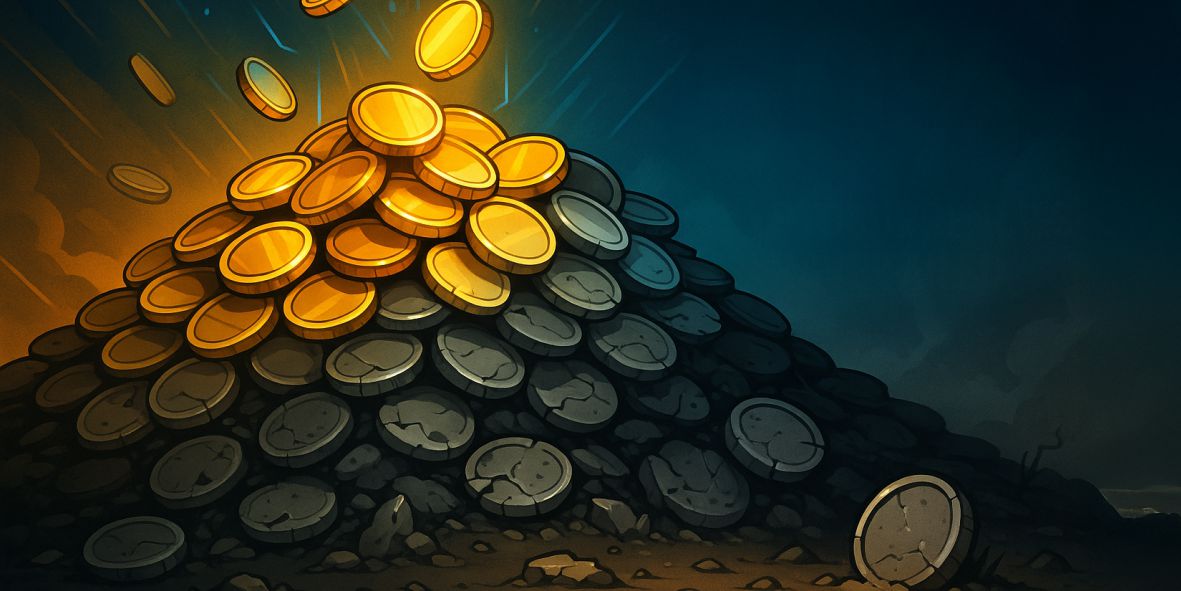Key Takeaways:
- 52.7% of all cryptocurrencies listed since 2021 are no longer active.
- Nearly 1.8 million token failures occurred in Q1 2025 alone.
- Rapid token creation fueled unsustainable launches.
- Memecoins lack long-term fundamentals and carry higher short-term risk.
- Traders are urged to research utility, liquidity, and tokenomics before investing.
More than half of all cryptocurrencies listed since 2021 have failed. As of March 31, 2025, 3.7 million out of nearly 7 million tokens tracked on GeckoTerminal are no longer actively traded, representing a 52.7% failure rate.
The majority of these failures occurred in 2024 and early 2025, driven by rapid token creation and worsening market conditions.
Early 2025 Marks the Sharpest Spike in Token Failures
According to a report shared by CoinGecko, the first quarter of 2025 alone saw the collapse of 1.8 million tokens, accounting for 49.7% of all recorded project failures.
The spike in token deaths coincided with a broader market downturn following Donald Trump’s inauguration in January 2025.
Token Creation Skyrockets, So Do Failures
The surge in failures also parallels a sharp increase in token creation. The total number of projects listed on GeckoTerminal rose from 428,000 in 2021 to nearly 7 million by 2025.
Furthermore, In 2024, nearly 1.4 million projects failed, representing 37.7% of all failures over the past five years. Before 2024, failures were relatively limited, with the years 2021 through 2023 accounting for just 12.6% of total project deaths.
Memecoin Launchpads Among the Main Drivers of Token Surge
According to the repost, a key factor behind this explosive growth in token listings is the rise of memecoin launchpads, particularly platforms like pump.fun.
Launched in 2024 on the Solana blockchain, pump.fun allowed anyone to deploy a token within minutes using a simple, gamified interface.
By drastically lowering the barrier to entry, such platforms fueled a wave of viral, community-driven meme tokens that often traded purely on hype, humor, or short-lived trends.
Unlike traditional project launches, these tokens typically lacked whitepapers, utility, or long-term roadmaps. Their primary appeal was speed and social momentum, making them ideal for short-term speculation but highly vulnerable to rapid collapse.
It’s worth noting that the study only included tokens with at least one recorded trade before becoming inactive. Additionally, only pump.fun tokens that had progressed beyond their initial launch phase were considered in the analysis.
What to Do as a Trader in a Volatile Crypto Market
Given the high failure rate of crypto projects, traders need to take a more cautious and informed approach by prioritizing risk management, thorough research, and careful evaluation of each project’s fundamentals.
One of the most critical steps for any trader is to understand a token’s core utility. Legitimate projects usually solve real-world problems or offer infrastructure that supports blockchain ecosystems—whether through smart contracts, cross-chain functionality, or data services.
In contrast, many memecoins are created purely for entertainment, trend-riding, or social clout, often lacking any meaningful use case or technical roadmap.
Liquidity is another major factor. Traders should examine how deep and sustainable liquidity pools are, as thin or temporary liquidity often signals limited commitment from developers or community support. Many tokens with inflated market caps suffer from low real liquidity, making it difficult to exit positions without slippage—especially during market downturns.
Tokenomics also matters. Key questions include:
- How are the tokens distributed?
- Are there large unlocks coming up?
- What portion is held by insiders or early backers?
These factors determine not just a token’s long-term sustainability, but also its short-term volatility.
Memecoins in particular tend to be short-term, high-risk plays. They often rely on viral attention, influencer tweets, or platform trends rather than product development.
While some memecoins have delivered massive returns during hype cycles, most offer little to no downside protection once momentum fades. In this environment, treating memecoins as long-term investments can be risky and unrealistic.
Finally, continuous research is key. Traders should monitor not just whitepapers and roadmaps, but also developer activity, community engagement, and protocol adoption.



